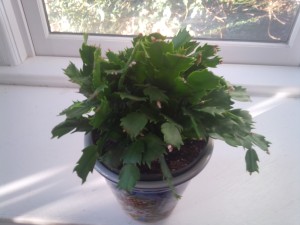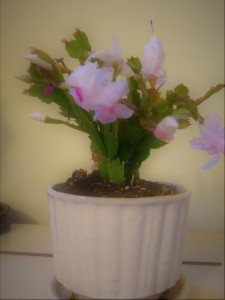 Every year I put off the inevitable—bringing houseplants indoors after their long summer vacation outside. I would like to think that my procrastination is motivated by a desire for the plants to soak up sunshine for as long as possible. Really though, I fear that my indoor spaces will be inundated by a high tide of potted plants. It happened last year and my designated plant areas, the sunny dining room window seat and the table in front of the big living room window, looked like mini jungles. Realistically, it is hard to give that many plants the kind of attention they need and deserve through the winter. Losing a few overwintering plants is inevitable, but when spring finally returns, the plant areas should not look like horticultural ICU’s.
Every year I put off the inevitable—bringing houseplants indoors after their long summer vacation outside. I would like to think that my procrastination is motivated by a desire for the plants to soak up sunshine for as long as possible. Really though, I fear that my indoor spaces will be inundated by a high tide of potted plants. It happened last year and my designated plant areas, the sunny dining room window seat and the table in front of the big living room window, looked like mini jungles. Realistically, it is hard to give that many plants the kind of attention they need and deserve through the winter. Losing a few overwintering plants is inevitable, but when spring finally returns, the plant areas should not look like horticultural ICU’s.
This fall, instead of trying in vain to find enough room and enough supplemental light for an army of geraniums, cannas, tradescantia and assorted tropical beauties, I am going to use overwintering strategies that will reduce work and effort, while preserving plant life. I like to think that a little planning will prevent a lot of desperation.
My daughter has an ongoing love affair with cannas. Last year I overwintered the containers in the house, watering on a regular schedule and hoping for the best. They survived and bloomed heartily this year. Since no good deed goes unpunished, my daughter invested in more cannas.
There are many ways to overwinter cannas. You can wait until frost withers the foliage, dig up the bulbs, let them dry a bit and then store them in a cool dry location. At winter’s end, you plant them again and with luck, they will start the growth cycle all over. You can also keep them in their containers, move the containers to a cool, frost-free location and let them go dormant naturally. When the weather warms up in spring, you take them outside, begin watering and feeding, and wait for new growth.
I am opting for that strategy. I already overwinter my potted roses that way and have succeeded well. The cannas will join them.
We have about a million geraniums, or so it seems when the time comes to make decisions about them. We could overwinter them all, but I would have to find the money for the immediate installation of a Victorian-type greenhouse to accommodate them. The will to do that might be strong, but the finances are weak. Instead I will make the tough decision to overwinter only the prettiest, most unusual ones and sacrifice the rest. Barring an apocalypse, the garden centers will once again be full of geraniums next year.
Even the most attractive annuals are by their nature expendable. Some will self-seed and pop up next year. Others will go the way of all things. When I pick up the new geraniums in mid spring, I will also buy more stocks, annual verbena and double impatiens. I may take cuttings from the Swedish ivy and root them. We will see if time permits.
I grow several tradescantias, including the striped Tradescantia pallida. Since these spiderworts are frequently grown indoors, I’ll trim their long, trailing stems and give them entry to the house. They do well on plant stands that save space and allow for their wandering growth habit.
Heavy lifting and overwintering is inevitable for some plants that might not survive cool space dormancy. This weekend, when I’m feeling strong, I’ll bring in the oleander, tea tree, and hibiscus. As I lug them in, I will remember to give thanks that the cannas are going into the garage.
I send several years’ worth of Christmas amaryllis outdoors every year. Instead of going through all the rigmarole involved in forcing holiday bloom by shutting them up in the dark for eight weeks before returning them to light and hydration, I treat them as ordinary houseplants. Consolidated into as few pots as possible, they return to my dining room, where they will be watered and fed. Eventually they will bloom on their own schedule, making for delightful surprises during the dark months. 
I would bring in the Christmas cactus, which is several seasons old, but it is already holding court inside. The infamous “Mission Impossible squirrel” chewed it almost to the point of no return in July and I brought it inside to save its life. Now it is hale and hearty and I am hoping that it will show its gratitude by popping a few blooms over the winter.
Some would call all of the above “lazy gardening” and they would be right. But I have to gin myself up for an orgy of late fall bulb planting, so I think of it as personal energy conservation. There is more to life than supervising the drying of canna bulbs—especially when I know that I will still be planting daffodils on Thanksgiving Day.
